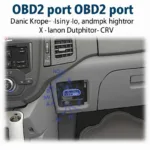A “Starting Disabled Service Throttle” message, coupled with a lack of OBD2 communication, can be a frustrating experience. This article will explore the reasons behind this issue, diagnostic steps, and potential solutions. We’ll delve into the complexities of electronic throttle control, OBD2 protocols, and the common causes for this communication breakdown.
Understanding the “Starting Disabled Service Throttle” Message
The “Starting Disabled Service Throttle” message typically indicates a problem with your vehicle’s electronic throttle control (ETC) system. This system manages the airflow into the engine, impacting acceleration and overall performance. When this system malfunctions, your car’s computer may disable the starting system as a safety precaution to prevent further damage. This often coincides with a loss of communication with the OBD2 port, making diagnosis more challenging.
Electronic Throttle Control (ETC) Explained
Unlike traditional cable-operated throttles, the ETC system uses electronic sensors and actuators to control the throttle valve. This allows for more precise control over engine performance and fuel efficiency. However, it also introduces complexities that can lead to issues like the one we’re discussing.
OBD2 Communication Breakdown: Why It Happens
The OBD2 port is the gateway to your car’s computer. When the “Starting Disabled Service Throttle” message appears alongside a lack of OBD2 communication, it suggests a potential problem within the communication network itself, or a critical failure within a component that affects the entire system. This could range from a faulty sensor, wiring harness issue, or even a problem with the car’s computer (ECU).
Diagnosing “Starting Disabled Service Throttle” and OBD2 Communication Failure
Diagnosing this issue requires a systematic approach. Here’s a breakdown of the steps you can take:
-
Check the Basics: Before diving into complex diagnostics, ensure the OBD2 port itself is not the issue. Try a different OBD2 scanner or check the fuse related to the OBD2 port. Sometimes, a simple fix is all that’s needed.
-
Inspect the Wiring Harness: A damaged or corroded wiring harness can disrupt communication between the ETC system, the ECU, and the OBD2 port. Carefully examine the wiring related to the throttle body, ECU, and OBD2 connector for any visible damage.
-
Test the Throttle Position Sensor (TPS): The TPS is a critical component of the ETC system. A faulty TPS can trigger the “Starting Disabled Service Throttle” message and disrupt communication. A multimeter can be used to test the TPS according to the manufacturer’s specifications.
-
Evaluate the Throttle Actuator Control (TAC) Module: The TAC module controls the throttle valve’s position. A malfunctioning TAC module can cause the throttle to stick or behave erratically, leading to the error message and communication issues.
-
Scan for Trouble Codes (If Possible): If you can eventually establish communication with the OBD2 port, retrieve any stored trouble codes. These codes can provide valuable insights into the root cause of the problem.
What if I Can’t Establish Communication at All?
If you’ve checked the basics and still can’t establish communication, the problem might be more serious. This could indicate a faulty ECU or a major wiring issue. In such cases, it’s best to consult a qualified mechanic with advanced diagnostic tools.
Solutions and Prevention
Once you’ve identified the cause of the problem, implementing the correct solution is crucial. This might involve:
- Replacing faulty sensors (TPS, etc.)
- Repairing or replacing the wiring harness
- Replacing the TAC module
- Addressing ECU issues
Preventing Future Issues
Regular maintenance and inspections can help prevent these issues from occurring. This includes checking the wiring harness for damage, cleaning the throttle body, and having the ETC system inspected by a professional.
Conclusion
Dealing with a “Starting Disabled Service Throttle” message and no OBD2 communication can be a daunting task. By understanding the intricacies of the ETC system and OBD2 protocols, following a systematic diagnostic approach, and implementing the appropriate solutions, you can overcome this challenge. Remember, regular maintenance is key to preventing future occurrences of this frustrating issue.
FAQs
-
Can a low battery cause this issue? While a low battery can cause erratic behavior in electronic systems, it’s less likely to be the direct cause of the “Starting Disabled Service Throttle” message and OBD2 communication failure.
-
Is it safe to drive with this message displayed? No, it is not safe to drive with this message displayed. The ETC system is crucial for controlling your vehicle’s speed and acceleration.
-
Will disconnecting the battery reset the system? Disconnecting the battery might temporarily clear the error message, but it won’t address the underlying problem.
-
How much does it cost to fix this issue? The cost of repair varies depending on the specific cause and the required parts.
-
Can I fix this issue myself? While some basic checks can be done at home, addressing more complex issues requires specialized knowledge and tools.
-
What should I do if I can’t establish communication with the OBD2 port? Consult a qualified mechanic with advanced diagnostic equipment.
-
How can I prevent this issue in the future? Regular maintenance, including inspections of the wiring harness and throttle body, is crucial for prevention.
Need help with your car diagnostics? Contact us via WhatsApp: +1(641)206-8880, Email: [email protected] or visit our workshop at 789 Elm Street, San Francisco, CA 94102, USA. Our 24/7 customer service team is ready to assist you.

